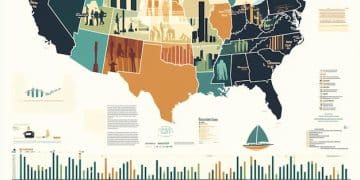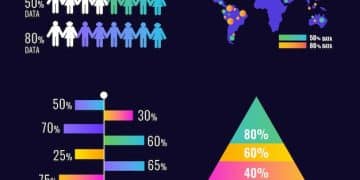2025 US Census Data: 5 Key Demographic Shifts & Policy Impact

The 2025 US Census Data: 5 Key Demographic Shifts Impacting National Policy will reveal critical changes in population dynamics, influencing everything from resource allocation to political representation, essential for informed governance and public understanding.
As the United States approaches 2025, the anticipation surrounding the release of new Census data is palpable. This decennial snapshot of the nation’s population dynamics promises to reveal profound shifts, offering invaluable insights into the evolving fabric of American society. For policymakers, researchers, and citizens alike, Unveiling the 2025 US Census Data: 5 Key Demographic Shifts Impacting National Policy will be more than just numbers; it will be a blueprint for understanding the challenges and opportunities that lie ahead, shaping national policy for decades to come.
Understanding the Census: A Foundation for Policy
The U.S. Census is far more than a simple head count. It’s a comprehensive demographic survey mandated by the Constitution, serving as the bedrock for federal resource allocation, political representation, and countless public and private sector decisions. Every ten years, this massive undertaking provides a detailed portrait of who we are, where we live, and how we’re changing.
Its primary purpose extends to ensuring fair political representation. The data collected directly impacts congressional apportionment, determining how many seats each state receives in the House of Representatives. This, in turn, influences the Electoral College and the balance of power in Washington. Beyond politics, census data guides the distribution of over $1.5 trillion annually in federal funding across various programs, ranging from education and healthcare to housing and infrastructure. Understanding these fundamentals is crucial as we delve into the specific shifts expected in 2025.
The Importance of Accurate Data Collection
The accuracy of census data is paramount. Undercounts or overcounts in specific populations can lead to significant disparities in funding and representation, disproportionately affecting vulnerable communities. Efforts to ensure comprehensive and equitable enumeration are continually refined, despite facing challenges such as mistrust, language barriers, and digital divides. The 2025 census will undoubtedly grapple with these complexities, striving for the most precise snapshot possible.
- Political Representation: Shapes congressional districts and electoral votes.
- Resource Allocation: Directs federal funding for critical public services.
- Economic Planning: Informs business decisions, market analysis, and job creation.
- Social Research: Provides crucial data for understanding societal trends and needs.
The preparations for the 2025 Census began years ago, incorporating lessons learned from previous iterations. Technological advancements, improved outreach strategies, and partnerships with local communities are all designed to enhance participation and data quality. This meticulous process underscores the profound impact the final data will have on the nation’s trajectory.
Shift 1: The Continuing Decline in Birth Rates and Aging Population
One of the most profound demographic shifts projected for 2025, building on established trends, is the continuing decline in birth rates alongside an increasingly aging population. This dual phenomenon has far-reaching implications for social security, healthcare, and the workforce.
For decades, the fertility rate in the U.S. has been below replacement level, meaning that without immigration, the population would eventually shrink. Factors contributing to this decline include economic uncertainties, changing social norms around family size, increased access to education and career opportunities for women, and delayed childbearing. As the baby boomers continue to age, the proportion of older adults in the population is growing rapidly, surpassing younger age groups.

Impact on Social Security and Healthcare
The aging population places significant strain on social security and Medicare. Fewer working-age individuals contribute to these systems, while more retirees draw benefits. This imbalance necessitates policy discussions around reforms to ensure the long-term solvency of these vital programs. Healthcare systems also face increased demand for geriatric care, chronic disease management, and specialized services, requiring substantial investments in infrastructure and personnel.
- Social Security Strain: Fewer contributors supporting more beneficiaries.
- Healthcare Demand: Increased need for geriatric and chronic care.
- Workforce Shortages: Potential decline in labor force participation and skilled workers.
- Economic Productivity: Concerns about innovation and economic growth with an older workforce.
Policy responses to these trends might include encouraging later retirement, reforming benefit structures, or increasing immigration to bolster the working-age population. The 2025 census data will provide updated projections, giving policymakers a clearer picture of the urgency and scale of these challenges.
Shift 2: Shifting Racial and Ethnic Composition
The United States has always been a mosaic of cultures, but the 2025 Census data will likely underscore the acceleration of its transformation into a more racially and ethnically diverse nation. This shift has been a consistent trend over the past few decades and is projected to continue, with significant policy implications across various sectors.
The proportion of the population identifying as Hispanic, Asian, and multiracial is growing at a faster rate than the non-Hispanic white population. This demographic transformation is driven by varying birth rates among ethnic groups and continued immigration patterns. By 2025, these groups are expected to constitute an even larger share of the total U.S. population, particularly among younger cohorts.
Policy Implications for Education and Cultural Integration
The changing racial and ethnic composition brings both opportunities and challenges for national policy. Education systems, for instance, must adapt to serve a more diverse student body, requiring investments in bilingual education, culturally competent curricula, and equitable access to resources. Public services, from healthcare to emergency response, will need to enhance their cultural responsiveness and language accessibility to effectively serve all communities.
Moreover, discussions around representation in government, media, and corporate leadership become even more pertinent. Policies aimed at promoting diversity, equity, and inclusion are likely to gain further momentum as the nation grapples with ensuring all voices are heard and valued. The 2025 data will highlight specific areas where these shifts are most pronounced, guiding targeted policy interventions.
Shift 3: Continued Urbanization and Suburban Sprawl
The magnetic pull of urban centers and the subsequent expansion into suburban areas continue to reshape the physical landscape of the U.S. The 2025 Census will likely reaffirm the growing concentration of the population in metropolitan areas, while also shedding light on the evolving dynamics between core cities and their surrounding suburbs.
While urban cores attract young professionals and offer diverse amenities, suburban areas continue to offer perceived advantages such as larger homes, better schools, and a more relaxed pace of life, appealing to families and those seeking more space. This dynamic has led to significant population growth in both urban and suburban areas, often at the expense of rural communities.

Infrastructure, Housing, and Environmental Policy Challenges
The continued urbanization and suburban sprawl pose critical challenges for infrastructure, housing, and environmental policy. Transportation systems become increasingly strained, demanding investments in public transit, road maintenance, and smart growth initiatives. Affordable housing in desirable urban and suburban areas remains a persistent issue, requiring policy solutions that promote development while preventing displacement.
- Infrastructure Strain: Increased traffic congestion and demand for public services.
- Affordable Housing Crisis: Rising housing costs in popular urban and suburban areas.
- Environmental Concerns: Loss of green spaces, increased energy consumption, and pollution.
- Resource Management: Challenges in water, waste, and agricultural land management.
Environmental policies must address the ecological footprint of expanding metropolitan regions, including issues like water usage, waste management, and the preservation of natural habitats. The 2025 data will provide detailed geographical breakdowns, enabling federal, state, and local governments to better plan for sustainable growth and development, ensuring that infrastructure keeps pace with population shifts.
Shift 4: Changing Household Structures and Living Arrangements
Beyond individual demographics, the 2025 Census will illuminate significant shifts in how Americans live, revealing an increasing diversity in household structures and living arrangements. The traditional nuclear family model, while still prevalent, is no longer the sole dominant form.
We expect to see a rise in single-person households, single-parent families, multi-generational households, and unmarried cohabiting couples. Economic pressures, evolving social norms, and increasing life expectancy all contribute to these changes. For instance, younger generations may opt to live with roommates longer due to high housing costs, while older adults may choose to live alone or with adult children. The data will provide a granular view of these evolving living patterns.
Impact on Social Services and Community Planning
These shifting household structures have profound implications for social services, urban planning, and the housing market. Policies related to childcare, elder care, and social support networks must adapt to serve a wider array of family configurations. Community planners need to consider the demand for diverse housing types, from smaller apartments catering to single individuals to larger homes suitable for multi-generational living arrangements. The 2025 census data will offer critical insights into these patterns.
Moreover, the concept of “community” itself is evolving. As traditional family structures diversify, the role of informal networks, local services, and civic organizations becomes even more crucial in providing support and fostering social cohesion. Understanding these nuances helps in designing effective social programs that genuinely meet the needs of all residents, promoting well-being across different demographic groups.
Shift 5: Educational Attainment and Workforce Evolution
The fifth key demographic shift the 2025 Census data is expected to highlight concerns the evolving landscape of educational attainment and its direct impact on the American workforce. Trends suggest a continued increase in higher education degrees, alongside a growing demand for specialized vocational skills.
More Americans are pursuing college degrees, reflecting both changing societal expectations and the increasing complexity of the job market. However, this trend is accompanied by an acknowledgment of the critical need for skilled trades and vocational training, suggesting a diversified pathway to professional success. The data will capture these educational shifts, providing a foundation for understanding future labor market dynamics.
Policy Frameworks for Economic Competitiveness
The implications for national policy are substantial, particularly in areas of economic competitiveness, workforce development, and immigration. Policies must support lifelong learning, ensuring that the workforce can adapt to technological advancements and evolving industry needs. Investments in both higher education and vocational training programs are crucial to addressing skill gaps and fostering innovation. The 2025 data is essential for assessing these educational shifts.
- Workforce Development: Programs for reskilling and upskilling workers.
- Educational Funding: Strategic investment in K-12, higher education, and vocational training.
- Economic Innovation: Fostering a skilled workforce capable of driving new industries.
- Immigration Policy: Attracting and retaining talent to meet labor demands.
Furthermore, immigration policies play a role in attracting talent and filling specialized roles where domestic supply may be insufficient. Understanding the educational attainment levels across various demographic groups will inform targeted interventions to promote equitable access to quality education and opportunities, ensuring the U.S. remains competitive on a global stage and that all citizens have pathways to prosperity.
| Key Shift | Brief Description |
|---|---|
| 👶 Declining Birth Rates | Fewer births combined with an aging population impacts social security and healthcare. |
| 🌎 Diverse Ethnic Composition | Rapid growth in Hispanic, Asian, and multiracial populations reshaping communities. |
| 🏙️ Urban/Suburban Sprawl | Increased population concentration in metropolitan areas challenges infrastructure. |
| 🎓 Educational Advances | Higher educational attainment and demand for specialized vocational skills drive workforce evolution. |
Frequently Asked Questions about the 2025 US Census Data
The 2025 US Census data is crucial because it directly influences the allocation of federal funding for countless programs, impacts political representation by determining congressional seats, and provides essential information for urban planning, economic development, and social services. It’s a fundamental tool for understanding national trends and making informed policy decisions.
Declining birth rates, coupled with an aging population, will significantly challenge social security and healthcare systems. Policymakers will face pressure to consider reforms to benefit structures, encourage later retirement, and potentially explore immigration strategies to bolster the working-age population and ensure the solvency of these vital programs for an older demographic.
A more racially and ethnically diverse population requires adaptation in various sectors, particularly education and public services. Policies will need to focus on culturally competent curricula, bilingual support, and equitable access to resources. Representation in government and leadership roles will also be a key policy discussion point to ensure all communities are heard and properly served.
Continued urbanization and suburban sprawl put immense pressure on infrastructure, housing, and environmental management. National policy must prioritize investments in transportation, affordable housing initiatives, and sustainable development practices to manage growth effectively. Addressing issues like traffic congestion, housing affordability, and environmental conservation becomes paramount for livable communities.
Educational attainment directly influences workforce development and economic competitiveness. Policy will need to support lifelong learning, invest in both higher education and vocational training to address skill gaps, and foster innovation. Strategic planning based on census data will ensure the U.S. labor force adapts to future economic demands and remains productive and globally competitive.
Conclusion
The 2025 US Census Data: 5 Key Demographic Shifts Impacting National Policy will offer an essential lens through which to view the evolving American landscape. From aging demographics and shifting ethnic compositions to urban growth and changing family structures, these trends are not mere statistics; they represent the ongoing narrative of a dynamic nation. Policymakers face the complex task of leveraging this data to craft informed, equitable, and forward-thinking policies that address the challenges and seize the opportunities presented by these profound transformations. The insights gleaned from the 2025 Census will undoubtedly shape the discourse and direction of the United States for years to come, demanding thoughtful consideration and proactive governance.





